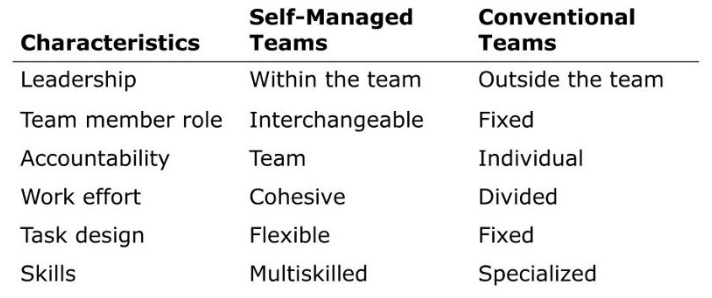Manajemen adalah subjek yang menonjol saat ini. Di mana pun ada orang, ada manajemen, termasuk manajemen perusahaan, manajemen ekonomi, manajemen administratif, manajemen rumah sakit, dan sebagainya. “Manajemen menghasilkan manfaat” juga merupakan kebenaran yang dipahami semua orang.
Selain mengelola hal-hal, Anda juga harus mengelola orang; Selain mengelola orang lain, Anda juga harus mengelola diri sendiri atau tim itu sendiri.
Berbicara tentang manajemen diri, ini juga merupakan pengetahuan yang sangat populer saat ini.
Tim yang dikelola sendiri adalah sekelompok karyawan yang bertanggung jawab atas semua atau sebagian besar aspek dalam memproduksi suatu produk atau layanan.

Tim yang dikelola sendiri adalah unit dasar dari organisasi horizontal baru. Tim yang dikelola sendiri merupakan perkembangan dari pendekatan tim sebelumnya.
Sebagai contoh, banyak perusahaan menggunakan tim lintas fungsi dan kelompok tugas yang berkolaborasi antar departemen untuk menyelesaikan proyek AD hoc.
Perusahaan lain menggunakan “tim pemecahan masalah”, yang terdiri dari pekerja sementara sukarela yang bertemu untuk membahas cara-cara meningkatkan kualitas, efisiensi, dan kondisi kerja.
Tim manajemen diri, juga dikenal sebagai tim yang diarahkan sendiri, biasanya terdiri dari 5 hingga 30 karyawan, mereka memiliki keterampilan yang berbeda, rotasi pekerjaan, untuk memproduksi seluruh produk atau menyediakan layanan, dan untuk mengambil alih tugas manajemen, seperti
- Pengaturan kerja dan liburan,
- Pesanan bahan baku,
- Merekrut anggota baru
Seperti namanya, tim yang dikelola sendiri adalah tim kerja yang mempertahankan sifat dasar dari tim kerja tetapi menambahkan karakteristik:
- Manajemen diri,
- Tanggung jawab diri dan
- Kepemimpinan diri ke dalam model operasinya.
Ada dua definisi utama:
Pertama, Hackman mengidentifikasi lima aspek perilaku manajemen diri dalam tim:
- Setiap anggota tim harus bertanggung jawab atas hasil kerja mereka sendiri;
- Setiap anggota tim memantau kinerja mereka sendiri dan terus-menerus mencari umpan balik;
- Setiap anggota tim mengelola kinerja mereka sendiri dan memperbaikinya;
- Setiap anggota tim secara aktif mencari bimbingan, bantuan, dan sumber daya dari perusahaan;
- Setiap anggota tim secara aktif membantu orang lain untuk meningkatkan kinerja mereka.
Kedua, menurut Wellinetal, tim kerja yang dikelola sendiri terdiri dari sekelompok karyawan dengan tanggung jawab berikut:
- Manajemen diri (perencanaan, organisasi, kontrol, personel, dan pemantauan);
- Menugaskan pekerjaan kepada anggota (menentukan pekerjaan apa yang dilakukan anggota kapan dan di mana);
- Merencanakan dan mengatur jadwal kerja (mulai dan selesai, kecepatan kerja, penetapan target);
- Mengambil keputusan terkait produksi (persediaan, kontrol kualitas, kontrol kerja);
- Menyelesaikan masalah (masalah kualitas, layanan pelanggan, disiplin).
Kedua definisi ini menjelaskan konotasi dasar dari tim yang dikelola sendiri dari sudut pandang yang berbeda. Tim manajemen diri terdiri dari 10–15 anggota dengan keterampilan profesional yang diperlukan, keterampilan interpersonal, keterampilan pemecahan masalah, dan keterampilan pengambilan keputusan. Tim menerapkan mekanisme operasi manajemen diri, tanggung jawab diri, kepemimpinan diri, dan pembelajaran diri untuk mencapai tujuan tim bersama.
Perbedaan antara Tim Konvensional dan Tim yang Dikelola Sendiri
Struktur organisasi tradisional menetapkan tugas sesuai dengan keterampilan profesional karyawan atau departemen fungsional tempat mereka bekerja. Tim manajemen diri terdiri dari berbagai peran yang dirancang untuk bekerja sama secara efektif dan mendistribusikan beban kerja secara merata kepada setiap anggota seluruh organisasi. Anggota tim diberikan peran sesuai dengan keterampilan dan gaya hidup mereka, dan mereka didorong untuk memperoleh praktik kerja terbaik mereka sendiri untuk memastikan bahwa mereka menikmati peran ini.

Manfaat Pendekatan Manajemen Diri
- Otonomi mendorong kekuatan: Studi telah menunjukkan bahwa otonomi adalah motivasi internal yang kunci.
- Otonomi mengarah pada kepemilikan: Dengan memungkinkan tim untuk membuat keputusan mereka sendiri, mereka merasa bahwa keberhasilan atau kegagalan keputusan tersebut adalah milik mereka. Orang secara alami ingin menguasai suatu tugas, sehingga keberhasilan membawa tingkat kontrol, motivasi, dan kesediaan yang tinggi untuk menyelesaikan masalah yang lebih sulit dan kompleks. Demikian pula, kegagalan mengarah pada refleksi dan perbaikan.
- Kecepatan keputusan: Membuat tim mengambil keputusan dapat menghemat banyak waktu. Seperti pepatah, waktu adalah uang.
- Kualitas keputusan:Ketika keputusan dibuat oleh seseorang yang tidak memiliki hubungan langsung dengan latar belakang pengambilan keputusan, ada banyak peluang untuk secara tidak sengaja membuat keputusan yang salah yang tampak masuk akal di permukaan. Mengambil keputusan dalam konteks dapat membantu menghindari situasi ini.
- Sistem Fokus Manajemen: Untuk banyak organisasi, manajemen menghabiskan banyak waktu untuk mengelola tugas dan karyawan. Ketika Anda memiliki tim yang mengorganisir diri sendiri, manajemen dapat menghabiskan lebih banyak waktu untuk tantangan sistemik, yang merupakan pekerjaan yang lebih berharga bagi mereka.
- Alat Agile Gratis dan Komersial Terbaik — Setiap Tim Scrum Membutuhkan!
- Daftar Periksa Scrum untuk Setiap Tim Scrum
- Apa itu Tim Scrum?
- Apa itu Tim yang Mengorganisir Diri Sendiri dalam Scrum?
- Bagaimana Tim Scrum Bekerja? — Panduan Singkat
- Tim Fitur vs Tim Komponen dalam Agile
- Apa itu Tim Lintas Fungsi dalam Agile?
This post is also available in Deutsch, English, Español, فارسی, Français, 日本語, Polski, Portuguese, Ру́сский, Việt Nam, 简体中文 and 繁體中文.













